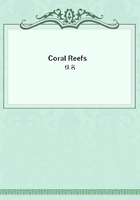
第33章
The same author has observed that the recoil of the sea from a steep shore is injurious to the growth of coral, although waves breaking over a bank are not so. Ehrenberg also states, that where there is much sediment, placed so as to be liable to be moved by the waves there is little or no coral; and a collection of living specimens placed by him on a sandy shore died in the course of a few days. (Ibid., page 49.) An experiment, however, will presently be related in which some large masses of living coral increased rapidly in size, after having been secured by stakes on a sandbank. That loose sediment should be injurious to the living polypifers, appears, at first sight, probable; and accordingly, in sounding off Keeling atoll, and (as will hereafter be shown) off Mauritius, the arming of the lead invariably came up clean, where the coral was growing vigorously. This same circumstance has probably given rise to a strange belief, which, according to Captain Owen (Captain Owen on the Geography of the Maldiva Islands, "Geographical Journal", volume ii., page 88.), is general amongst the inhabitants of the Maldiva atolls, namely that corals have roots, and therefore that if merely broken down to the surface, they grow up again; but, if rooted out, they are permanently destroyed. By this means the inhabitants keep their harbours clear; and thus the French Governor of St. Mary's in Madagascar, "cleared out and made a beautiful little port at that place." For it is probable that sand would accumulate in the hollows formed by tearing out the corals, but not on the broken and projecting stumps, and therefore, in the former case, the fresh growth of the coral might be thus prevented.
In the last chapter I remarked that fringing-reefs are almost universally breached, where streams enter the sea. (Lieutenant Wellstead and others have remarked that this is the case in the Red Sea; Dr. Ruppell ("Reise in Abyss." Band. i., page 142) says that there are pear-shaped harbours in the upraised coral-coast, into which periodical streams enter. From this circumstance, I presume, we must infer that before the upheaval of the strata now forming the coast-land, fresh water and sediment entered the sea at these points; and the coral being thus prevented growing, the pear-shaped harbours were produced.) Most authors have attributed this fact to the injurious effects of the fresh water, even where it enters the sea only in small quantity, and during a part of the year. No doubt brackish water would prevent or retard the growth of coral; but I believe that the mud and sand which is deposited, even by rivulets when flooded, is a much more efficient check. The reef on each side of the channel leading into Port Louis at Mauritius, ends abruptly in a wall, at the foot of which I sounded and found a bed of thick mud. This steepness of the sides appears to be a general character in such breaches. Cook (Cook's "First Voyage," volume ii., page 271 (Hawkesworth's edition).), speaking of one at Raiatea, says, "like all the rest, it is very steep on both sides." Now, if it were the fresh water mingling with the salt which prevented the growth of coral, the reef certainly would not terminate abruptly, but as the polypifers nearest the impure stream would grow less vigorously than those farther off, so would the reef gradually thin away. On the other hand, the sediment brought down from the land would only prevent the growth of the coral in the line of its deposition, but would not check it on the side, so that the reefs might increase till they overhung the bed of the channel. The breaches are much fewer in number, and front only the larger valleys in reefs of the encircling barrier class. They probably are kept open in the same manner as those into the lagoon of an atoll, namely, by the force of the currents and the drifting outwards of fine sediment. Their position in front of valleys, although often separated from the land by deep water lagoon-channels, which it might be thought would entirely remove the injurious effects both of the fresh water and the sediment, will receive a simple explanation when we discuss the origin of barrier-reefs.
In the vegetable kingdom every different station has its peculiar group of plants, and similar relations appear to prevail with corals. We have already described the great difference between the corals within the lagoon of an atoll and those on its outer margin. The corals, also, on the margin of Keeling Island occurred in zones; thus the Porites and Millepora complanata grow to a large size only where they are washed by a heavy sea, and are killed by a short exposure to the air; whereas, three species of Nullipora also live amidst the breakers, but are able to survive uncovered for a part of each tide; at greater depths, a strong Madrepora and Millepora alcicornis are the commonest kinds, the former appearing to be confined to this part, beneath the zone of massive corals, minute encrusting corallines and other organic bodies live. If we compare the external margin of the reef at Keeling atoll with that on the leeward side of Mauritius, which are very differently circumstanced, we shall find a corresponding difference in the appearance of the corals. At the latter place, the genus Madrepora is preponderant over every other kind, and beneath the zone of massive corals there are large beds of Seriatopora.
There is also a marked difference, according to Captain Moresby (Captain Moresby on the Northern Maldiva atolls, "Geographical Journal", volume v., page 401.), between the great branching corals of the Red Sea, and those on the reefs of the Maldiva atolls.